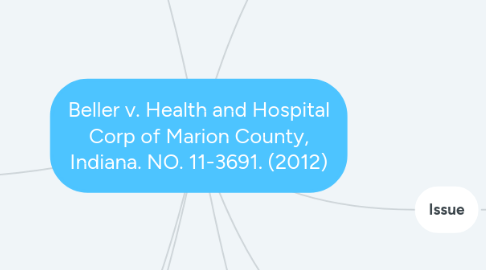
1. Rule of Law
1.1. EMTALA
1.1.1. EMTALA was enacted to address the problem of patient "dumping" to ensure fair treatment of uninsured patients
1.1.1.1. EMTALA imposes two duties on hospitals: 1) provide medical screening for any emergency condition and 2) to stabilize the patient prior to any transfer to another facilitiy
1.1.1.2. 2001 definition states comes to the emergency room means that the individual is on the hospital property...property includes ambulances owned and operated by the hospital even if the ambulance is not on hospital grounds
1.1.1.3. 2003 amendment stated that a patient was not deemed to have come to the emergency room if 1) the ambulance is under communitywide EMS protocols that direct it to transport the individual to a hospital other than he hospital that owns the ambulance, or 2) the ambulance is operated at the direction of a physician who is not employed or otherwise affiliated with the hospital that owns the ambulance
2. Analysis/Application
2.1. EMTALA
2.1.1. Was the patient on hospital grounds?
2.1.1.1. No
2.1.2. Was the patient in an ambulance owned and operated by Wishard?
2.1.2.1. Yes
2.1.3. Was the ambulance operating under EMS protocols (per 2003 definition)?
2.1.3.1. Yes
2.2. Is the 2003 definition a change of law and thus not retroactive, or it is a clarification and thus retroactive?
2.2.1. DHH 2003 definition repeatedly states the Final Rule changes were clarifications.
2.2.1.1. The title states: 'Clarifying Policies Related to the Responsibilities of Medical - Participating Hospitals in Treating Individuals With Emergency Medical Conditions"
2.2.1.2. "both reiterated the agency's interpretations under EMTALA and proposed clarifying changes relating to the implementation of the EMATLA provisions"
2.2.1.3. "reiterations and clarifying changes are needed to ensure uniform and consistent application of policy and to avoid any misunderstanding of EMTALA requirements by individuals, physicians, or hospital employees"
2.2.1.4. "we proposed to clarify"
2.2.1.5. "proposal to clarify that EMTALA does not apply to hospital-owned ambulance when the ambulance is operation under communitywide protocols that require it to transport..."
2.2.2. The 2003 definition is a clarification and thus retroactive.
2.3. Did the district court give undue deference to the agency (DHSS)?
2.3.1. The intent of the promulgating agency must be accorded great weight (Clay, 264 F.3d at 749
2.3.2. No.
3. Conclusion
3.1. Court found that the 2003 definition is a clarification and thus applicable. Decision of the district court is AFFIRMED.
4. Influence
4.1. More hospitals are willing to own and operate fleets of ambulances under EMS protocols
4.2. Patients would arguably receive better care by transporting the patient to the most appropriate hospital
5. Facts
5.1. Parties
5.1.1. Joshua Beller, a minor, by his mother Melissa Welch, Plaintiffs/Appellants
5.1.2. Health and Hospital Corp. of Marion County, Indiana, d/b/a Wishard Memorial Hospital, d/b/a Wishard Ambulance Service, Defendant/Appellee
5.2. What Happened
5.2.1. June 14, 2001: Welch, at 34 weeks pregnant called 911 and dispatch sent Wishard ambulance to her home
5.2.2. Paramedics ascertained her water broke and she had a prolapsed umbilical cord, for which the tried to relieve pressure
5.2.3. Paramedics consulted with nurse from Welch's ob office and agreed to transport her to nearest hospital
5.2.4. She was transported to Beech Grove emergency room, which does not have an obstetrics facility
5.2.5. Physician examined her and sent her in the same ambulance to St Francis South
5.2.6. Joshua Beller was delivered via C-section but had suffered hypoxia resulting in severe brain damage
5.3. Procedural History
5.3.1. Plaintiffs sued alleging Wishard had violated the EMTALA by transferring Joshua to Beech Grove instead of stabilizing him
5.3.1.1. Plaintiffs claimed they had "come to the emergency room" of Wishard when they were transported in the Wishard ambulance, per the 2001 definition of DHHS promulgation of EMTALA
5.3.2. District Court ruled in favor of the defendant, holding the 2003 definition of "comes to the emergency department" was a clarification to the law that applied retroactively
5.3.3. Plaintiff appealed, claiming 1) the amendment to the definition constituted a change in law rather than a clarification, which cannot be applied retroactively, and 2) even it was a clarification, the court gave undue deference to the clarification and did not conduct its own analysis
6. Issue
6.1. Which definition from DHHS of EMTALA applies? The 2001 or the 2003?
7. Impact
7.1. This case was referenced a few times for its simplistic definition of the intent of EMTALA is to prevent patient "dumping"
7.1.1. Gillispie v. RegionalCare Hospital Partners, Inc.
7.1.2. Muzaffar v. Aurora Health Care Southern Lakes, Inc.

